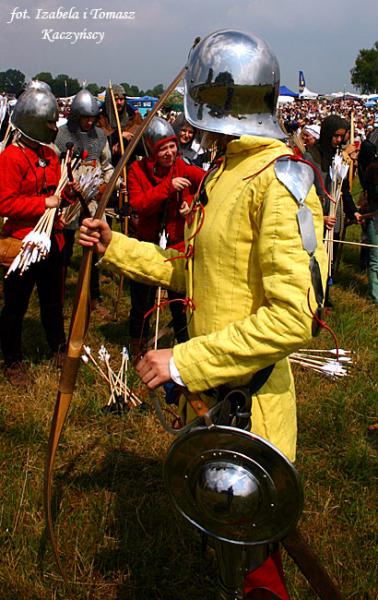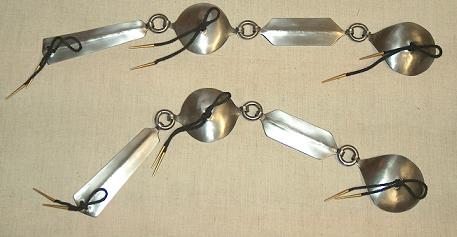Posts: 508
Mon 19 Dec, 2005 8:16 am
These are really interesting. I've never heard of them before.
| Jakob Elbęk E. Pedersen wrote: |
A soldier wearing a tight padded jack with jack-chains can be seen on the Reliquary of St. Ursula by Hans Memling; http://www.wga.hu/art/m/memling/4ursula/36ursu06.jpg c. 1489.
For more info see,
Medieval Military Costume - Recreated in Colour Photographs by Gerry Embleton, p. 64-65.
As far as I am concerned no original examples of jack-chains exist today. But there may have been found fragments, which has not yet been recognised as such.
/Jakob |
On a related issue, the soldier in that picture who has the jackchains (is this the authentic name for them BTW?) seems to be wearing his gambeson/padded jack over a mail shirt. What are the advantages of wearing the gambeson over rather than under mail?
Posts: 936 Location: WV
Mon 19 Dec, 2005 3:08 pm
heres teh thing.
in the 15th cen, later (war of the roses) the gambison changed to a tight fighting arming jacket. armour was then tied to it etc. one could wear a mail shirt over it and a jack (many layered garment, i mean like 20-30 layers of linen) a mail shirt was not always worn with a jack.
a jack was made to slow down arrows. via it is the greandfather to the kevlar vest. there have only been 1-4 found and prof cant deside if they are indeed jacks or arming jackets etc.
a lot of illustraters make it seem as though the mail is a full shirt. and sometimes it is in period paintings and sometimes its not. mails voiders (under arms or jsut shoulders), standards (neck) and a mail skirt or shorts are worn and are pointed to teh arming jacket. covering the essncal areas
and as far as i know, jack chains are called jack chains. no real reference off hand for another name
Posts: 95 Location: Kitchener, Ontario
Mon 19 Dec, 2005 5:03 pm
I could imagine these miniscule pieces of armour would provide some descent protection at a very low cost. You have to figure, if you are using a pole arm such as a glaive, partizan halberd etc... your arms are probably going to be a high priority target especially if you engage someone else with a pole arm. However Plate armor is VERY expensive. So the adage of these simple low cost metal bands would not only prevent cuts, but effectively stop an enemy's blow from breaking your arm.
Posts: 936 Location: WV
Mon 19 Dec, 2005 5:44 pm
right :)
also when looking at 15thc paitnings (WOTR) just look at how many people do not have their legs armoured. usually only mounted guys.
so teh jack chains stop the brakeage of arms while teh jack stops the slicing of skin
Posts: 108
Thu 22 Dec, 2005 11:02 pm
Also in
Medieval Military Costume - Recreated in Colour Photographs by Gerry Embleton
I noticed that on the color plate on page 89, there is a small copy of a Landsknecht woodcut from 1515 that illustrates jackchains being worn over a puff and slash doublet. It has interesting clam shell shaped elbow cops too.
Posts: 9,545 Location: Dayton, OH
Thu 29 Dec, 2005 2:08 pm
Hey guys,
Here's a pic of one of the displays at the
Frazier Historic Arms Museum. I believe it's the Towton tableau.
 Attachment: 32.91 KB
Attachment: 32.91 KB
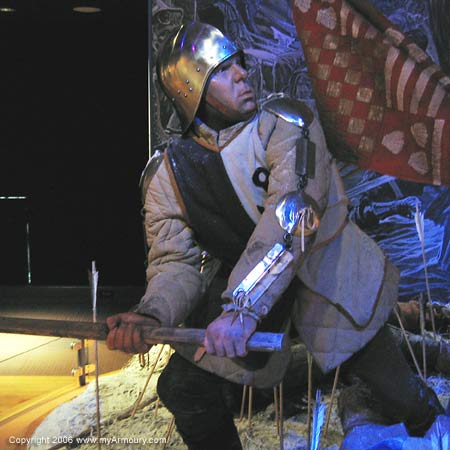
Posts: 425 Location: Cincinnati OH
Tue 28 Mar, 2006 3:22 pm
Here is an image from a book I recently picked up. It is the effigy of the Margrave Rudolph IV of Baden-Durlach in Lichtental, Germany who died in 1348. Note the clear presence of splints on his arms over his mail, similar to jackchains . I found this interesting as it is at least a century before what I would have though of as normal for the use of jackchains.
 Attachment: 105.88 KB
Attachment: 105.88 KB
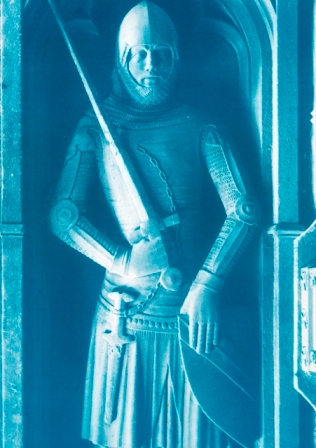
Margrave Rudolph IV
Posts: 470
Tue 28 Mar, 2006 6:18 pm
intriguing and exciting! This is the first I've seen of "jack chains" (I use the term loosely as they are more accurately splints, I think) in their developed form on anything other than 15th century men at arms. Hardened leather would seem more plausable considering the date, but I don't know. . . have to study the picture more. Mark, what book have you got if you don't mind my asking.
Thanks again for the pic!
Posts: 425 Location: Cincinnati OH
Tue 28 Mar, 2006 7:46 pm
The book is "The Knight Triumphant: The High Middle Ages, 1314 - 1485" by Stephen Turnbull.
http://www.myArmoury.com/books/item.php?ASIN=0304359718
Posts: 9,545 Location: Dayton, OH
Tue 28 Mar, 2006 7:49 pm
I don't know if I'd call those true jack-chains. That effigy is from the late end of splinted armour, which I think is a better term. Whether jack-chains are an outgrowth of splinted armour like that or not, though, is an intriguing question. :)
Posts: 425 Location: Cincinnati OH
Tue 28 Mar, 2006 7:52 pm
| Chad Arnow wrote: |
| I don't know if I'd call those true jack-chains. That effigy is from the late end of splinted armour, which I think is a better term. Whether jack-chains are an outgrowth of splinted armour like that or not, though, is an intriguing question. :) |
Good point Chad. The pieces seem to be connected rather close together so there isn't much "chain" there. Still, the evolution of the form seems to be suggested by this earlier style. Would make an interesting area of research (and a good article :p )
Posts: 301 Location: Brisbane, Australia
Wed 29 Mar, 2006 5:58 am
Jack Chains
Posts: 616 Location: Toronto, Canada
Wed 29 Mar, 2006 9:43 am
| Craig Peters wrote: |
It's been suggested that jack-chains are used for protective purposes. This may well be true; however, how do we know that they were not used for some other purpose rather than protection? |
They invariably cover the points of shoulder and elbow as well as outside of uppper and lower arm. None of them are depicted with heraldic insignia. None are worn loose like a purely decorative element. Each is depicted in a logical position to protect an exposed and easily injured part of the body.
What else might they be if not to supplement the defenses of a lightly armoured infantryman? :wtf:
Posts: 585 Location: Poland
Wed 29 Mar, 2006 11:20 am
If I am correct the first picture in the topic is the example of Tomasz Samula's work...I had a pleasure to have a close look when I was in his workplace...Very nice piece for a light infantryman :cool:
Posts: 198
Fri 31 Mar, 2006 6:19 am
a close up of the painting
 Attachment: 24.03 KB
Attachment: 24.03 KB
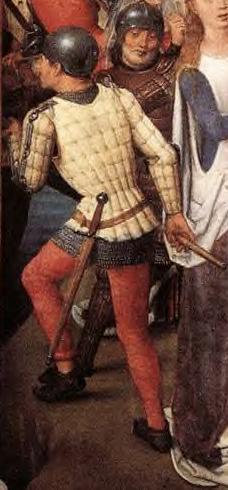
Posts: 5,981 Location: Birmingham, Alabama
Wed 10 Oct, 2007 6:58 am
I wanted to revive this topic for a few reasons:
-I still think this is a fascinating topic
-I'm thinking about making a set of chains as a good introductory armouring project
-I just noticed that Patrick Thaden has discounted a set of very nice jack chains--just $75! Maybe it's worth it to him, but that would probably work out to significantly less than minimum wage for me. Seems like a great bargain.
http://www.thadenarmory.com/sell/specials/specials.htm
 Attachment: 65.94 KB
Attachment: 65.94 KB
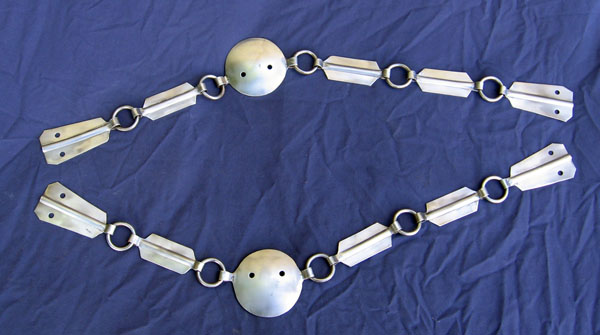
Posts: 2,121 Location: Northern Utah
Wed 10 Oct, 2007 7:34 am
Craig,
They seems to be pure protection items. They are often listed in inventories and purchase with munition like suits, sallets, arms splints, breastplates in the same orders. The middle ground between these and full arms seems to win out in the early 16th with the splint arms which basically are couters of very simple nature with a two-three inch wide plate that is rectangular for the upper arm and somewhat rectangular piece that is longer for the lower arm. I do not know how long the chain variety holds on as it could be called splints instead in the 16th.
Very nice looking reproductions. I'd love to go visit the Frazier. Though the Royal Armoury is actually closer...
RPM
You
cannot post new topics in this forum
You
cannot reply to topics in this forum
You
cannot edit your posts in this forum
You
cannot delete your posts in this forum
You
cannot vote in polls in this forum
You
cannot attach files in this forum
You
can download files in this forum


